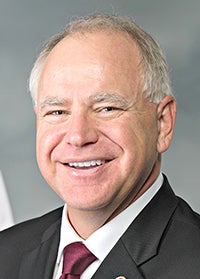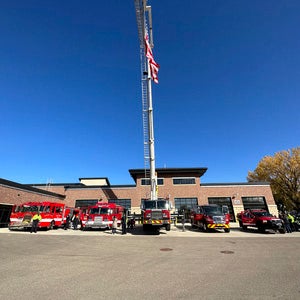Walz plan slow-walks bar, restaurant restarts
Published 3:27 pm Wednesday, May 20, 2020
|
Getting your Trinity Audio player ready...
|
By Brian Bakst, Minnesota Public Radio News
In a cautious plan for reopening close-contact businesses, Gov. Tim Walz on Wednesday said restaurants can start serving sit-down customers beginning June 1 — but only at outdoor tables.

Tim Walz
He’s stopping short of letting customers sit at the bar, in restaurant dining rooms or other indoor tables for now. Hair care businesses can provide in-shop services at a limited capacity.
The governor is unveiling the plan now to reporters:
Walz said he was trying to give “as much consistency and predictability” as possible, and that the ongoing restrictions on daily life are maddening and frustrating, especially for bars and restaurants that he called integral to Minnesota life, but the virus won’t allow business as usual.
“These health guidelines are not an impediment to opening the economy. They’re key to opening up the economy,” Walz said.
Under Walz’s plan, restaurant staff would have to wear masks; customers who are waiting for food would be encouraged to. There must be 6 feet between tables, and patios will have to operate at a lower capacity than normal. Curbside pickup for takeout food would be permitted as before.
The governor’s new guidance will permit a gradual reopening of personal care businesses, such as barbershops, salons and tattoo parlors. They would be required to have clear plans for social distancing, sanitizing and other safety measures to keep coronavirus risks down, including operating at 25 percent capacity at first.
An administration document says youth sports training can resume per Health Department guideline but no games can be played. Campgrounds and charter boats are now considered “open”
Gyms and other entertainment venues that attract crowds are not part of this round of reopenings.
The governor has previously said June 1 was his goal to reopen establishments as well as salons and barbershops, bowling alleys, theaters and other places of public accommodation.
It’s not clear what the reaction will be from bar and restaurant owners who’ve become increasingly concerned they’ll go under if they can’t reopen soon to dine-in customers.
Walz’s two-month stay-at-home order expired Monday. While the order pushed back the disease’s peak in Minnesota and bought officials time to prep the health care system for a surge, it delivered a huge economic blow to Minnesota’s restaurant and hospitality industry.
Strategy paying off?
The plan comes as Minnesota’s COVID-19 toll continues to rise, with the state on Wednesday reporting 777 deaths since the pandemic began, up 29 from Tuesday. The number of Minnesotans currently hospitalized rose slightly to 550 while those needing intensive care slipped to 212.
Walz has said he won’t hesitate to retighten restrictions if coronavirus cases shoot up and hospitals come under strain. He kept the stay-home order in place for about two months to check the spread of the disease and push back the expected peak so it would not overwhelm the state’s health care system, one of his biggest fears.
While deaths, case counts and hospitalizations are still growing, there are signs now that the strategy is paying off despite the economic pain it’s triggered.
Health Commissioner Jan Malcolm on Tuesday noted that the time it now takes for case counts to double is stretching out longer — about 13 days currently — helping to make the spread of the disease more manageable.
On Wednesday, statistics showed that of the 17,670 people who’ve tested positive for the disease in Minnesota since the pandemic began, nearly 70 percent have recovered to the point they no longer need to be isolated.
Health officials say they’re watching several key metrics to gauge if the disease is accelerating as restrictions are lowered. Among them: the number of days it takes for cases to double, the amount of daily testing, the proportion of positive tests and the level of community spread that can’t be traced to specific contacts — an indication the disease might be more widespread.
The state continues to add investigators to contact those infected and work to reach others who might have had contact with them and might also be potentially infected.
Even as that tracing work intensifies, it’s possible that many who became infected may never know the source of the infection given that people with no symptoms can have the coronavirus and unknowingly pass it on.
Despite the investigation and tracing efforts, “not everyone is going to be able to say ‘I got it from Fred’ or ‘I got it from Frieda,’” said Kris Ehresmann, the state’s infectious disease director. “For many situations, you may not know where you picked it up.”
While the numbers of positive tests and hot spots for the disease are spread across sectors and regions of Minnesota, more than 80 percent of those who’ve died from the disease were living in long-term care, nearly all had underlying health problems.
On Tuesday, officials also announced that the state has purchased a former food warehouse in St. Paul to use as a temporary morgue in case COVID-19 deaths overwhelm existing capacity.
A purchase agreement released by the Minnesota Department of Administration on Tuesday shows the state paid about $5.5 million for the 71,000-square-foot property. State officials say the space is expected to have capacities to hold up to 5,100 bodies, and could be needed if predictions of 1,000 deaths per week at the coronavirus peak hold up.
Meatpacking hot spots remain
Many of the recent outbreaks outside the Twin Cities metro area are focused around meatpacking plants. Officials have intensified testing in those hot spots, uncovering more infections.
On Tuesday, Malcolm said health leaders were focused on eight counties outside the Twin Cities metro area where outbreaks were centered around packing plants.
In southwestern Minnesota’s Nobles County, where an outbreak hit Worthington’s massive JBS pork plant, about 1 in 16 people have tested positive for COVID-19. In mid-April, there were just a handful of cases. By Tuesday, there were 1,396 confirmed cases, although the numbers are rising at a much slower rate than in previous weeks.
The JBS plant shut on April 20 but has since partially reopened with expanded hygiene and health monitoring measures.
Similar problems have been reported in Stearns County, where COVID-19 cases tied to two packing plants — Pilgrim’s Pride poultry plant in Cold Spring and Jennie-O Turkey in Melrose — have skyrocketed. An undisclosed number of workers at both plants have tested positive for the virus.
There were about 55 confirmed cases in Stearns County two weeks ago. By Wednesday, confirmed cases were at 1,831 with 11 deaths.
Kandiyohi County in west-central Minnesota is also seeing cases continue to climb a month after officials with the Jennie-O turkey processing plant there said some employees had tested positive for the coronavirus. The county had confirmed three COVID-19 cases then.
On Wednesday, the Health Department reported 426 people have now tested positive.
While the counts in those counties are high relative to their population, officials say the growth in new cases in those areas appears to be stabilizing.


